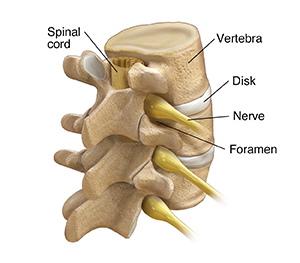Understanding Foraminotomy
A foraminotomy is a surgery to widen an area in one of your spinal bones (vertebrae). This takes pressure off a nerve that is compressed by the surrounding bone.
About your spine
Your backbone, or spinal column, is made up of a chain of bones called the vertebrae. Your spinal cord runs through the spinal column. The bones help protect the spinal cord from injury. Disks sit between each vertebra to provide cushioning and support. Large nerves called nerve roots exit the spinal cord through small holes between the bones called foramen. These nerve roots send and receive signals to and from the body. The signals are sent to and from your brain through the spinal cord.
In some people, the foramen can become too small. This is called foraminal stenosis, or spinal stenosis. This puts pressure on the nerve roots. The pressure can cause symptoms like pain, tingling of your arms or legs, and weakness. Your symptoms will vary depending on which nerve is compressed. For example, a compressed nerve in your neck may lead to neck pain and tingling and weakness in your hand and arm. A compressed nerve in your lower back may cause lower back and leg pain or tingling.

Why a foraminotomy is done
A number of things can block your foramen and squeeze a nerve root leaving your spinal cord. Problems that can cause spinal stenosis include:
-
Degenerative arthritis of your spine (spondylosis) that can cause bony spurs
-
Degeneration of the disks that cause them to bulge into the foramen
-
Enlargement of the nearby ligament
-
A vertebra moving out of place (spondylolisthesis)
-
Cysts or tumors
-
Skeletal disease, such as Paget disease
-
Congenital problems, such as dwarfism
You may need a foraminotomy if other treatments have not worked, such as physical therapy, pain medicine, or epidural injections. In some cases, an emergency foraminotomy may need to be done. This may be the case if your symptoms get worse quickly or if you lose bladder control because of the compressed nerve.
How a foraminotomy is done
The surgery is done by a neurosurgeon or orthopedic surgeon. The surgery can be done in several ways. During the procedure, you will lie on your stomach. The surgeon will make small cuts in the skin just beside your spine, near your symptoms. They will use small tools to remove the blockage inside the foramen. This may be a bone spur or a bulging disk. This will relieve pressure on the nerve root.
Risks of foraminotomy
Every surgery has risks. Risks for this surgery include:
The risk for complications can vary depending on certain reasons. These include your age, your general health, which vertebra is affected, the size and shape of your foramen, and how the surgery is done. Ask your healthcare provider about the risks that most apply to you.
Online Medical Reviewer:
Esther Adler
Online Medical Reviewer:
Raymond Kent Turley BSN MSN RN
Date Last Reviewed:
9/1/2025
© 2000-2025 The StayWell Company, LLC. All rights reserved. This information is not intended as a substitute for professional medical care. Always follow your healthcare professional's instructions.